

Perennial plant. A perennial plant or simply perennial (from Latin per, meaning "through", and annus, meaning "year") is a plant that lives for more than two years.[1] The term is often used to differentiate a plant from shorter-lived annuals and biennials.

The term is also widely used to distinguish plants with little or no woody growth from trees and shrubs, which are also technically perennials.[2] Perennials, especially small flowering plants, that grow and bloom over the spring and summer, die back every autumn and winter, and then return in the spring from their root-stock, are known as herbaceous perennials. Herbaceous plant. Trientalis latifolia (Broadleaf Starflower) is a perennial herbaceous plant of the ground layer of forests in western North America.
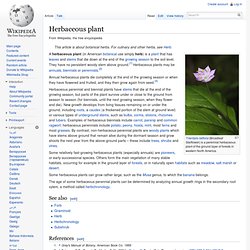
A herbaceous plant (in American botanical use simply herb) is a plant that has leaves and stems that die down at the end of the growing season to the soil level. They have no persistent woody stem above ground.[1] Herbaceous plants may be annuals, biennials or perennials.[2] Annual herbaceous plants die completely at the end of the growing season or when they have flowered and fruited, and they then grow again from seed.[3] Some relatively fast-growing herbaceous plants (especially annuals) are pioneers, or early-successional species. Others form the main vegetation of many stable habitats, occurring for example in the ground layer of forests, or in naturally open habitats such as meadow, salt marsh or desert.
Wormwood. Trees & Shrubs. A tree typically has many secondary branches supported clear of the ground by the trunk.

This trunk typically contains woody tissue for strength, and vascular tissue to carry materials from one part of the tree to another. For most trees it is surrounded by a layer of bark which serves as a protective barrier. Below the ground, the roots branch and spread out widely; they serve to anchor the tree and extract moisture and nutrients from the soil.
Above ground, the branches divide into smaller branches and shoots. The shoots typically bear leaves, which capture light energy and convert it into sugars by photosynthesis, providing the food for the tree's growth and development. Trees play a significant role in reducing erosion and moderating the climate. Definition Diagram of secondary growth in a eudicot or coniferous tree showing idealised vertical and horizontal sections. Shepherdia canadensis. The plant is a deciduous shrub found in open forests and thickets all over North America. Its northern limit is around the Arctic Circle. The shrub reaches a height of 1–4 m (3–13 feet). Fruits are extensively collected by some Canadian First Nations peoples such as Nlaka'pamux (Thompson), St'at'imc (Lillooet) and Secwepemc (Shuswap) in the province of British Columbia.
The bitter berries are not eaten directly but rather processed as sxusem ("sxushem", also xoosum/"hooshum") or "Indian ice-cream". Mooseberry (soapberry) Highbush Cranberry - Viburnum trilobum. Detail of the inflorescence Description[edit]
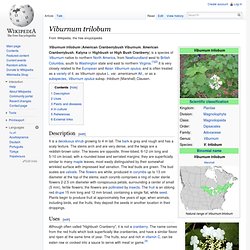
Populus Genus. Populus is a genus of 25–35 species of deciduous flowering plants in the family Salicaceae, native to most of the Northern Hemisphere.

English names variously applied to different species include poplar /ˈpɒp.lər/, aspen, and cottonwood. Description[edit] Willow Genus. Willows, sallows, and osiers form the genus Salix, around 400 species[2] of deciduous trees and shrubs, found primarily on moist soils in cold and temperate regions of the Northern Hemisphere.

Most species are known as willow, but some narrow-leaved shrub species are called osier, and some broader-leaved species are referred to as sallow (from Old English sealh, related to the Latin word salix, willow). Some willows (particularly arctic and alpine species) are low-growing or creeping shrubs; for example, the dwarf willow (Salix herbacea) rarely exceeds 6 cm (2 in) in height, though it spreads widely across the ground. Description[edit] Red willow (alder) As food.
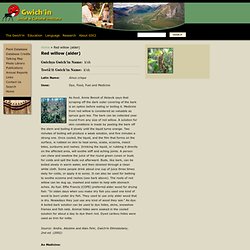
Annie Benoit of Aklavik says that scraping off the dark outer covering of the bark is an option before eating or boiling it. Medicine from red willow is considered as valuable as spruce gum tea. The bark can be collected year round from any size of red willow. A solution for skin conditions is made by peeling the bark off the stem and boiling it slowly until the liquid turns orange. Two minutes of boiling will produce a weak solution, and five minutes a strong one. Black currant. Gwich'in Social and Cultural Institute (GSCI) Bait. Birch. As food.
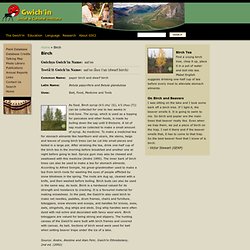
Poplar. As medicine.
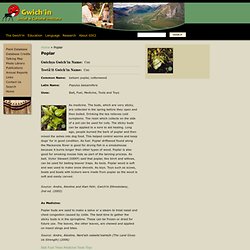
The buds, which are very sticky, are collected in the spring before they open and then boiled. Drinking the tea relieves cold symptoms. Cleaners. Horsetail. As Medicine: The horsetail plant is used to make a medicinal tea to treat kidney problems, bladder infections or urinary track problems.

To treat a bladder infection, a tea is made with the horsetail plant and large amounts of the tea are taken to clear the condition. A cup of the tea is taken two or three times during the night. Cups of horsetail tea are also taken during the day along with spruce pitch tea for three days. Moss (sphagnum moss) White moss (Reindeer lichen) This lichen grows in large mats in spruce forests, where it is often eaten by caribou. According to Alfred Semple, Lazarus Sittichinli said it takes a long time to grow.
He also told Alfred that if you eat animals that eat willow, like moose, you will get hungry more quickly than eating animals that eat lichen, like caribou. Food. Rubus chamaemorus. Unlike most Rubus species, the cloudberry is dioecious, and fruit production by a female plant requires pollination from a male plant. The cloudberry grows to 10–25 cm high. The leaves alternate between having 5 and 7 soft, handlike lobes on straight, branchless stalks. After pollination, the white (sometimes reddish-tipped) flowers form raspberry-sized berries. Encapsulating between 5 and 25 drupelets, each fruit is initially pale red, ripening into an amber color in early autumn.
Distribution and ecology[edit] Cloudberries occur naturally throughout the Northern Hemisphere from 78°N, south to about 55°N, and very scattered south to 44°N mainly in mountainous areas. The cloudberry can withstand cold temperatures down to well below -40°C, but is sensitive to salt and to dry conditions. Cloudberry leaves are food for caterpillars of several Lepidoptera species. Labrador tea - dwarf. Bear root. Bearberry (birdâs eye) Birch. Black currant.
Blackberry. Blueberry. Cranberry. As food, cranberries can be eaten raw or added to breads, pies and muffins. Cranberry jam, jelly or syrup can be made by boiling the berries in sugar with water. A pudding or sauce can be made by adding a paste made of flour or custard to boiled berries. Cranberries can also be enjoyed by mixing them with cooked and mashed loche liver. It’suh, a Gwich’in dessert prepared from pounded dry fish, can be made with cranberries, a bit of sugar and fish oil. Fireweed - tall. Horsetail. Flooring. Willow. Spruce. For food. Dwarf birch. Fire Starters. Birch and Willow fungus. Spruce. Dyes. Cranberry. Red willow (alder) Diapers. Moss (sphagnum moss)